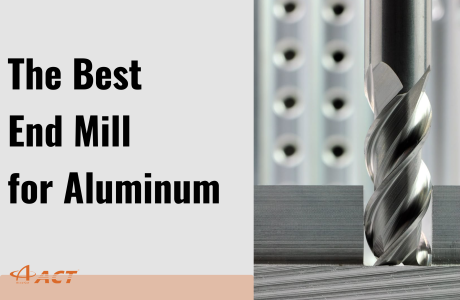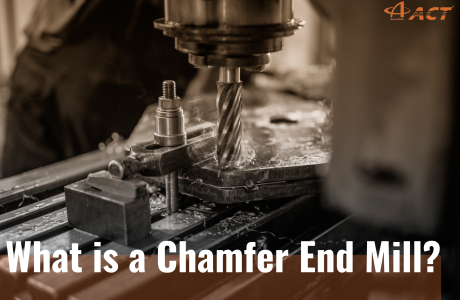CNC milling is a cornerstone of modern manufacturing, helping produce everything from bodies of space shuttles, electric cars to smartphones. This technology enables the production of intricate parts and components with high precision and accuracy.
In this article, we will cover CNC milling in detail, discussing its benefits, applications, and types of machines. We will also guide you on selecting the right CNC milling machine for your project.
What is CNC Milling?
CNC milling is a subtractive manufacturing process that uses computer-controlled cutting tools to remove material from a workpiece to create the desired shape.
CNC in CNC milling stands for Computer Numerical Control, and it refers to the automation of machine tools by means of computers executing pre-programmed sequences of digital instructions.
Who Invented CNC Milling?
The concept of CNC milling began in the 1940s with John T. Parsons, who proposed using punched cards to control machine tools, which laid the groundwork for CNC technology.
The first true CNC milling machine was developed in the early 1950s by Richard Kegg and his team at MIT's Servomechanisms Laboratory. In 1952, they created the first commercially available CNC milling machine.
Since then, CNC milling has seen numerous advancements, including the development of more complex machines and greater automation, making it a cornerstone of modern manufacturing.

What are the Advantages of CNC Milling?
High precision, consistency, flexibility and production speed are the main advantages of CNC milling compared to traditional machining process.
Unlike early NC (Numeric Control) machines that rely on punched cards for movement control, which require much more manual interventions during operation, CNC machines use fully digital instructions.
This significantly reduces the chance of human error, allowing the machine to produce the same part repeatedly with consistent quality. And with programs stored digitally, operation retrieval, modification, and reuse are much easier.
By automating processes and eliminating the need for multiple setups, CNC machines can perform complex operations in a single setup. This streamlines production, reduces downtime, and increases efficiency.
What are the Limitations of CNC Milling Machines?
While CNC milling machines are incredibly versatile and powerful, they do have some limitations. Here are a few you should be aware of:
-
Size Constraints: CNC milling machines have physical size limitations. Large parts may not fit within the machine's working envelope.
For example, a standard CNC milling machine might have a work envelope of 40 inches by 20 inches by 25 inches. This means it can only handle parts that fit within those dimensions.
For very large components, other machining methods or larger, specialized CNC machines might be necessary.
-
Geometric Limitations: The physical limits of the tools and the machine's movement make certain shapes and geometries difficult to achieve with CNC milling alone.
For example, internal sharp corners and deep cavities with small radii are particularly challenging. This is because the round cutting tools used in CNC milling cannot create perfectly sharp internal corners and may struggle to reach deep, narrow spaces.
-
Production Speed: For high-volume production of simple parts, other methods like injection moulding or stamping might be faster and more cost-effective.
CNC milling is excellent for low to medium-volume production and prototypes, but it might not be the best choice for mass production of simple parts.
What Can You Make with CNC Milling Machines?
CNC milling is the go-to for high-precision, complex parts across various materials, from aluminum and steel to advanced composites and plastics.
Its ability to execute detailed toolpaths and maintain tight tolerances is the key for maintaining the quality and performance standards required in various industries. Here are some examples of what you can make with CNC milling:
- Mechanical Parts: such as brackets, gears, and shafts used in various machinery and equipment.
- Aerospace Components: including airframe parts, engine components, and landing gear elements.
- Automotive Parts: such as engine blocks, transmission housings, and suspension components that are crucial for vehicle performance.
- Medical Devices: including prosthetic parts, surgical instruments, and implants that demand high accuracy and biocompatibility.
- Consumer Electronics: such as enclosures, heat sinks, and mounting brackets for phones, laptops, and other electronic devices.
- Industrial Machinery: including tooling components, machine frames, and fluid control systems parts like pumps and valves.
- Custom Projects: such as prototypes, artistic pieces, and custom hardware tailored to specific needs and designs.

What Materials do CNC Milling Machine Use?
Materials used in CNC milling machines are mainly grouped into hard metals, soft metals, and non-metals.
These include hard metals like cast iron, steel, and titanium, soft metals like aluminum, copper, and brass, and non-metals such as plastics, wood, and MDF.
Choosing the right material comes down to the specific application requirements and desired properties of the final product.
What's the Difference Between CNC Milling and CNC Turning?
In CNC milling, a rotating cutting tool removes material from a stationary workpiece. The machine moves the cutting tool in different directions to shape the material into the desired form. Imagine it like a sculptor carving out a statue by moving their tool around a block of stone.
On the other hand, CNC turning involves a machine that rotates the workpiece itself while the cutting tool remains stationary. The cutting tool stays in one place but can move closer to or further from the spinning material. This process is great for making cylindrical parts like shafts, screws, or any round-shaped objects.
Learn More: What is CNC Turning?
CNC Milling Operation Process
Step 1: Create a CAD Model
Typically, designers or machinists create a CAD (Computer-Aided Design) model of the part they want to produce. This contains all the necessary details and dimensions of the part.
Learn More: What is Computer-aided Design (CAD)?
Step 2: Convert CAD to G-code
Once the design is ready, they use CAM (Computer-Aided Manufacturing) software to convert it into a language that the CNC milling machine can understand, which is called G-code.
G-code is a set of instructions that tells the CNC machine exactly how to move: what path to follow, how fast to go, and how deep to cut.
Learn More: What is Computer-aided Manufacturing (CAM)?
Step 3: Set Up the CNC Milling Machine
Next, the workpiece is secured on the machine bed through clamping or fastening to make sure it doesn't move during the milling process.
Then, the cutting tool is installed in the machine spindle and all necessary setup steps are completed for the milling machine.
Step 4: Execute the Milling Process
Once everything is set up, load the G-code program into the CNC milling machine. Start the machine, and it will follow the programmed instructions to perform the milling process.
During this process, operators monitor the machine to ensure everything runs smoothly and make adjustments if necessary.
Step 5: Inspection and Finishing
After the milling process is complete, the part should be carefully inspected to ensure it meets all the specified dimensions and tolerances.
Any necessary finishing touches, such as deburring (removing sharp edges) or polishing, will also be applied to improve the part's appearance and functionality.
CNC Milling Machine Types
Let's take a look at the different types of CNC milling machines:
3-Axis Milling Machines
A 3-axis milling machine moves the cutting tool along three linear axes: X, Y, and Z. The X-axis is horizontal, the Y-axis is vertical, and the Z-axis is depth.
These machines are suitable for creating simple parts and are widely used for milling operations like drilling, slotting, and cutting basic shapes.
4-Axis Milling Machines
A 4-axis milling machine includes all the capabilities of a 3-axis machine but also adds rotation around the X-axis, known as the A-axis.
This additional rotation is especially helpful when milling parts with curved, inclined, or sloped surfaces. The machine can rotate the part, allowing the cutting tool to reach and machine these details accurately.
5-Axis Milling Machines
A 5-axis milling machine have all the capabilities of a 4-axis machine but adds a second rotational axis. This can be the B-axis (rotation around the Y-axis) or the C-axis (rotation around the Z-axis).
This expanded range of motion allows the cutting tool to machine highly complex geometries, such as twisted and contoured shapes, in a single setup.

Vertical Milling Machines
Vertical milling machines feature a vertically oriented spindle, with the cutting tool moving up and down.
It's perfect for projects where you need to work on large, flat surfaces. Imagine creating a detailed engraving on a metal plate - that's where a vertical mill shines. It's also easier to set up and great for smaller shops due to its compact design.
Horizontal Milling Machines
A horizontal CNC mill has its spindle set horizontally. This setup is ideal for cutting across a piece of material.
Think about it like slicing through a loaf of bread - horizontal mills excel at cutting deep and fast. They're fantastic for heavy-duty jobs and can handle larger, bulkier pieces with ease.
CNC Milling Machine Parts & Tools
- Worktable: The worktable is where the workpiece is secured during the milling process. It moves along the X and Y axes to position the workpiece accurately under the cutting tool.
- Saddle: The saddle supports the worktable and allows it to move in the Y-axis direction. It sits on the knee and moves horizontally.
- Knee: The knee supports the saddle and the worktable. It moves vertically along the Z-axis, adjusting the height of the worktable.
- Spindle: The spindle holds and rotates the cutting tool. It is the main part of the milling machine that drives the cutting tool to perform the machining operations.
- Arbor: The arbor is an extension of the spindle. It holds various milling cutters and allows them to be attached to the spindle for different milling operations.
- Ram: The ram supports the spindle and allows it to move forward and backward along the Y-axis. This provides additional flexibility in positioning the cutting tool.
- Machine Tools: Machine tools include various cutting tools, such as end mills, drills, and face mills, used to remove material from the workpiece. Each tool is selected based on the specific operation required.
Read More: How to Choose the Right End Mill for Your Projects? - Interface: The interface refers to the control panel and software used to operate the CNC milling machine. It allows the operator to input instructions, set parameters, and monitor the machining process.
How Much Do CNC Milling Machines Cost?
The cost of a CNC milling machine can vary widely depending on various factors such as the machine's size, brand, features and customization. Here's a general overview of the cost range:
Entry-Level CNC Mills
They typically cost between $2,000 to $10,000, which are suitable for hobbyists or small businesses. These machines usually comes with smaller size, and fewer capabilities compared to industrial-grade machines.
Mid-Range CNC Mills
These are more suitable for small to medium-sized businesses that need higher precision and capabilities. They usually cost between $10,000 to $100,000.
High-End CNC Mills
These are industrial-grade machines designed for large-scale manufacturing. They can cost anywhere from $100,000 to several hundred thousand dollars. High-end CNC mills offer the highest precision, speed, and automation features, and are capable of handling complex and large-scale projects.

Top CNC Milling Machine Brands
Haas
Haas Automation, founded in 1983 by Gene Haas, is one of the leading manufacturers of CNC machine tools in America.
Known for its robust, high-performance milling machines, Haas offers a diverse range of products that cater to various machining needs, making them a popular choice among small to mid-sized manufacturers.

Fanuc
Fanuc Corporation, established in Japan in 1956, is a world-renowned leader in CNC systems and robotics.
Fanuc's CNC milling machines are celebrated for their advanced automation capabilities and precision engineering. Fanuc is particularly known for its innovative approaches to machine learning and artificial intelligence in manufacturing.

DMG Mori
DMG Mori, a merger of the German company Gildemeister and the Japanese company Mori Seiki in 2013, is a global powerhouse in the CNC machining industry.
DMG Mori offers a wide array of CNC milling machines that combine German engineering precision with Japanese technological innovation, catering to high-end manufacturing industries such as aerospace, automotive, and medical devices.

Okuma
Okuma Corporation, founded in 1898 in Japan, is one of the oldest and most respected names in the CNC machining industry.
The company focuses on providing comprehensive solutions that include machine tools, control systems, and software, ensuring optimal performance and productivity in various manufacturing applications.

Mazak
Yamazaki Mazak Corporation, established in 1919 in Japan, is a global leader in the production of advanced CNC machining centers.
Mazak is renowned for its innovative multi-tasking machines that combine milling, turning, and other processes in a single setup. They are the preferred choice for manufacturers aiming to enhance productivity and reduce lead times in complex machining tasks.

About ACCU-CUT
Accu-Cut, based in Taiwan, is dedicated to quality and innovation in cutting tools. Our tools are crafted with premium materials and feature expertise in unique coatings.
We exclusively incorporate AlTiCrN coating, enhancing toughness, durability, and cutting ability. This commitment ensures our tools deliver superior results while providing optimal equipment protection.
At Accu-Cut, we are committed to delivering tools that not only excel in performance but also redefine precision and durability, setting new benchmarks in the industry.



